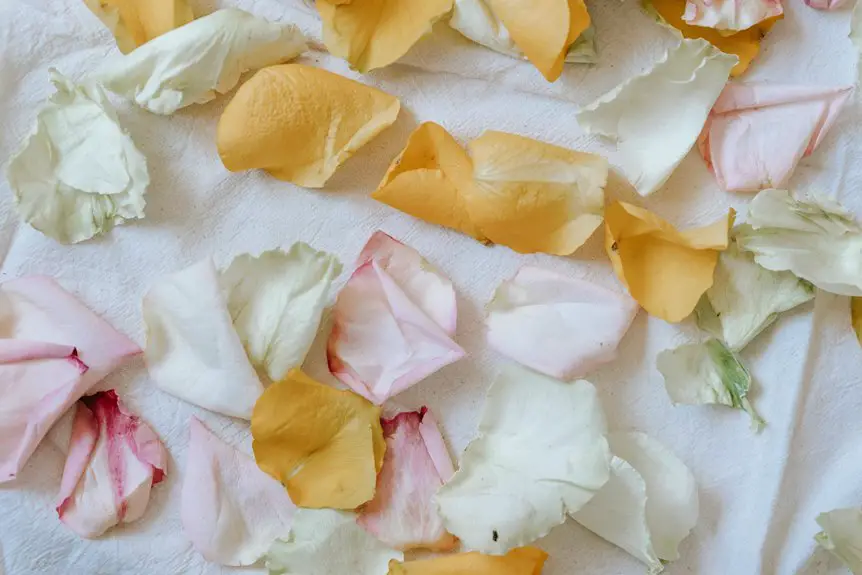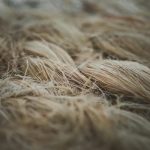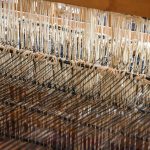When choosing between acetate and triacetate fabric, know that acetate feels smooth and silky but is more delicate and heat-sensitive, while triacetate offers greater durability, heat resistance, and a crisper texture. Acetate suits flowing dresses and linings, whereas triacetate works well for structured garments and upholstery thanks to its wrinkle resistance. Both come from cellulose but differ in production and care needs. Keep exploring to uncover which fabric best fits your project’s demands and style.
Table of Contents
Key Takeaways
- Acetate fabric is smooth and silky with a soft sheen, while triacetate has a brighter luster and a crisper, firmer texture.
- Triacetate is more durable and heat-resistant compared to the delicate and heat-sensitive acetate.
- Both fabrics originate from cellulose, but triacetate undergoes additional chemical treatment for enhanced strength and wrinkle resistance.
- Acetate is preferred for lightweight, flowing garments and linings; triacetate suits structured clothing, upholstery, and uniforms.
- Care for both involves gentle washing and low-heat ironing, but triacetate requires less maintenance due to its resilience.
Understanding the Basics of Acetate Fabric
Acetate fabric offers a smooth, silky texture that many find appealing for clothing and upholstery. When you choose acetate, you’re picking a textile made from cellulose fibers derived from wood pulp or cotton linters. It mimics the look and feel of silk but comes at a lower cost.
You’ll notice acetate drapes well and has a lustrous finish, making it ideal for elegant dresses, linings, and decorative fabrics. However, it’s sensitive to heat and can shrink or melt if exposed to high temperatures, so you’ll want to handle it carefully during washing and ironing.
Plus, acetate doesn’t absorb moisture well, which means it can feel less breathable compared to natural fibers. Understanding these basics helps you decide if acetate suits your needs.
What Is Triacetate Fabric?
You’ll find triacetate fabric is made from cellulose fibers treated to improve durability and wrinkle resistance.
Its production involves a unique chemical process that sets it apart from acetate.
Let’s explore what makes triacetate special and why it might be the right choice for your wardrobe.
Triacetate Fabric Composition
Although triacetate shares some similarities with acetate, it’s a distinct type of fabric made by chemically modifying cellulose fibers with acetic acid.
When you look closer, triacetate fibers contain a higher degree of acetylation compared to acetate, meaning more hydroxyl groups in the cellulose are replaced with acetyl groups.
This change impacts the fiber’s properties, making triacetate more durable, wrinkle-resistant, and heat-stable than acetate.
You’ll find that triacetate fabric blends the natural origin of cellulose with enhanced synthetic qualities, giving it a unique balance of softness and resilience.
Because of this composition, triacetate handles heat better, making it ideal for garments that require frequent ironing or exposure to higher temperatures.
Understanding its makeup helps you appreciate why triacetate performs differently from acetate in everyday use.
Production Process Overview
Since triacetate fabric starts with cellulose fibers, its production involves a chemical process that transforms these natural materials into a more durable and heat-resistant textile. You’ll see that cellulose is first extracted from wood pulp, then treated with acetic acid and acetic anhydride. This treatment changes the fiber’s molecular structure, giving triacetate its unique properties. Afterward, the fibers are spun into yarns and woven or knitted into fabric.
| Step | What Happens | How It Feels to You |
|---|---|---|
| Cellulose Extraction | Wood pulp is prepared | Natural, pure, raw |
| Chemical Treatment | Fibers react with acids | Transformative, precise |
| Fiber Spinning | Fibers become yarn | Smooth, controlled |
| Weaving/Knitting | Fabric formation | Soft, tactile |
| Finishing | Final touches applied | Ready, reliable |
Key Characteristics and Benefits
Understanding how triacetate fabric is made helps explain why it stands out in performance and feel.
You’ll notice its unique blend of durability and softness, making it a favorite for garments that need to look sharp yet feel comfortable. Triacetate resists wrinkles better than acetate, so your clothes stay crisp longer. It also tolerates heat well, allowing easy ironing without damage.
Here’s what you can expect from triacetate fabric:
- Smooth, silky texture that feels luxurious against your skin
- High wrinkle resistance for a polished look all day
- Excellent drape, enhancing the flow of dresses or skirts
- Heat and moisture resilience, perfect for easy care and durability
With these benefits, triacetate offers a practical yet elegant option for your wardrobe.
How Acetate and Triacetate Are Made
When you look closely at how acetate and triacetate fabrics are made, you’ll find they both start from cellulose, a natural polymer derived from wood pulp or cotton linters.
For acetate, the cellulose undergoes a chemical process called acetylation, where it reacts with acetic anhydride, producing cellulose acetate. This compound is then dissolved, extruded through spinnerets, and solidified into fibers.
Triacetate takes this a step further; during its production, the cellulose is fully acetylated and then modified with additional chemicals like formaldehyde to enhance its properties. This extra step changes the fiber’s structure, giving triacetate distinct characteristics.
Both fibers are spun into filaments or staple fibers, ready to be woven or knitted into fabric. Understanding this process helps you appreciate their similarities and subtle differences.
Comparing the Durability of Acetate and Triacetate
Although both acetate and triacetate fabrics share a common origin, they differ noticeably in durability. You’ll find acetate is more delicate, prone to wrinkles, and sensitive to heat. Triacetate, on the other hand, offers enhanced strength and resilience, making it better suited for everyday wear.
When comparing durability, consider these points:
- Acetate wrinkles easily, requiring careful ironing
- Triacetate resists wrinkles and maintains shape longer
- Acetate can weaken with repeated exposure to heat and moisture
- Triacetate withstands heat better and holds up through multiple washes
Knowing these differences helps you choose the right fabric based on how much wear and care you’re willing to give your clothing.
Understanding fabric durability guides your clothing choices and care commitment.
Triacetate generally lasts longer with less maintenance.
Differences in Appearance and Texture
You’ll notice acetate has a soft sheen, while triacetate offers a brighter luster.
Both fabrics feel smooth, but triacetate tends to be a bit firmer to the touch.
Understanding their texture and drape helps you pick the right fabric for your project.
Sheen and Luster
Sheen plays a significant role in how acetate and triacetate fabrics catch your eye. Acetate tends to have a soft, subtle shine that feels elegant but not overpowering, while triacetate offers a brighter, more pronounced luster due to its slightly different chemical makeup.
This difference affects how light reflects off the fabric, influencing your overall impression.
When you look closely, you might notice:
- Acetate’s gentle glow, like candlelight on silk
- Triacetate’s sharper sparkle, similar to a polished pearl
- Soft highlights that shift as you move in acetate
- A crisp, reflective surface with triacetate’s sheen
Understanding these nuances helps you choose the perfect fabric based on the kind of visual impact you want.
Fabric Softness Comparison
When you touch acetate and triacetate fabrics, their differences in softness become clear.
Acetate feels smooth and soft against your skin, offering a gentle, almost silky sensation. It’s lightweight and pleasant to wear, making it ideal for delicate garments.
Triacetate, while still soft, has a slightly firmer hand. You’ll notice it’s less slippery and holds its shape better, giving it a more structured feel. This firmness doesn’t mean it’s rough; instead, triacetate provides a balanced softness that’s durable and less prone to wrinkles.
So, if you prefer a fabric that feels luxuriously smooth, acetate suits you. But if you want softness combined with resilience and shape retention, triacetate might be your better choice.
Both offer comfort, but their softness caters to different preferences.
Texture and Drape
Beyond softness, the way acetate and triacetate fabrics look and move plays a big role in their appeal. When you touch acetate, you’ll notice a smooth, almost silky texture that feels light and airy on your skin.
Triacetate, on the other hand, has a slightly heavier feel with a crisp finish, giving your clothes a more structured drape. Both fabrics reflect light beautifully, but triacetate tends to hold pleats and shapes better, making it ideal for tailored garments.
Picture this:
- Acetate flowing gently in a soft breeze
- Triacetate maintaining sharp, clean folds
- A glossy sheen catching the light subtly
- Fabric that moves effortlessly yet holds form
Choosing between them depends on whether you want fluidity or structure.
Care and Maintenance Tips for Both Fabrics
Although acetate and triacetate fabrics have different properties, you can care for both with similar simple steps to keep them looking their best.
Always check the care label first, but generally, hand washing in cold water with a mild detergent works well. Avoid wringing; instead, gently squeeze out excess water to prevent damage.
When drying, lay your garment flat on a clean towel or hang it to air dry—never use a dryer, as heat can cause shrinkage or warping.
If ironing is necessary, use a low heat setting and place a pressing cloth between the iron and fabric to avoid melting.
Finally, store your acetate or triacetate items away from direct sunlight and humidity to maintain their shape and color longer.
Common Uses for Acetate Fabric
Understanding how to care for acetate fabric helps you appreciate why it’s chosen for certain applications. Its silky feel and lustrous finish make it a favorite in fashion and home décor.
You’ll often find acetate used where elegance and drape are key.
Here are common uses for acetate fabric:
- Evening gowns and formal dresses that require a smooth, shiny appearance
- Linings in jackets and coats to provide a sleek, comfortable layer
- Drapery and curtains where a soft sheen enhances room aesthetics
- Blouses and scarves that benefit from acetate’s lightweight and breathable nature
When you pick acetate, you’re choosing a fabric that combines beauty with practicality in these specific uses.
Popular Applications of Triacetate Fabric
Triacetate fabric stands out for its durability and wrinkle resistance, making it a practical choice for many uses. If you need a fabric that maintains shape and looks polished, triacetate works well for garments like suits and dresses. It’s also popular in home décor, especially for curtains and upholstery, thanks to its vibrant colors and resistance to shrinking. Additionally, triacetate is common in linings and uniforms where longevity matters.
| Application | Reason for Use |
|---|---|
| Suits & Dresses | Wrinkle resistance & durability |
| Curtains | Color retention & shrink resistance |
| Upholstery | Long-lasting & easy care |
| Linings | Smooth finish & durability |
| Uniforms | Hard-wearing & shape retention |
Environmental Impact and Sustainability Considerations
When you choose acetate or triacetate fabric, it’s important to contemplate their environmental impact. Both come from cellulose, a renewable resource, but their production involves chemicals that can affect ecosystems.
Triacetate generally uses a more complex process, which might mean higher energy consumption. However, triacetate’s durability means garments last longer, reducing waste.
Consider these factors:
- Chemical use in manufacturing and potential water pollution
- Energy consumption during production processes
- Biodegradability and how quickly each fabric breaks down
- Longevity of the fabric, impacting how often you replace items
Choosing the Right Fabric for Your Project
How do you decide whether acetate or triacetate fabric suits your project best? Consider the end use, durability needs, and care requirements. Acetate offers a luxurious sheen and softness, ideal for formal wear or linings. Triacetate provides better wrinkle resistance and durability, perfect for everyday garments or items needing frequent washing.
Here’s a quick comparison to help you decide:
| Feature | Acetate | Triacetate |
|---|---|---|
| Appearance | Lustrous, smooth | Slightly less shiny |
| Durability | Moderate, delicate handling | High, resists wrinkling |
| Care | Dry clean recommended | Machine washable possible |
| Best Use | Formal wear, linings | Casual wear, uniforms |
| Environmental Impact | Less sustainable | More sustainable option |
Match fabric traits to your project’s priorities for the best results.
Frequently Asked Questions
Can Acetate or Triacetate Fabrics Cause Allergic Reactions?
Like Pandora’s box, fabrics can sometimes hide surprises. You might react to acetate or triacetate if you’re sensitive, but allergies are rare. Always test new fabrics on a small skin patch before wearing them extensively.
Do Acetate and Triacetate Fabrics Shrink After Washing?
You might notice acetate fabrics shrink a bit if washed improperly, while triacetate resists shrinking better. To keep both in shape, use cool water and gentle cycles, and avoid high heat when drying.
Are Acetate and Triacetate Fabrics Suitable for Outdoor Use?
You shouldn’t rely on acetate or triacetate fabrics for outdoor use since they’re not very UV-resistant and can degrade with prolonged sun exposure. They’re better suited for indoor or occasional outdoor wear where durability matters less.
How Do Acetate and Triacetate Fabrics Perform in Extreme Temperatures?
You’ll find acetate fabric struggles in extreme heat, as it can melt or deform. Triacetate handles higher temperatures better, resisting heat damage, so it’s more suitable if you expect exposure to intense heat or fluctuating temperatures.
Can Acetate or Triacetate Fabrics Be Recycled Effectively?
You can recycle both acetate and triacetate fabrics, but it’s tricky. They require specialized processes, so not all recycling centers accept them. Check locally and consider donating or repurposing to reduce waste effectively.
- The Use of Nonwovens in Construction and Civil Engineering - July 11, 2025
- The Use of Nonwovens in Construction and Civil Engineering - July 11, 2025
- The Use of Nonwovens in Construction and Civil Engineering - July 11, 2025







